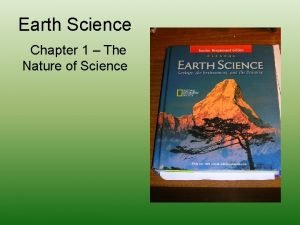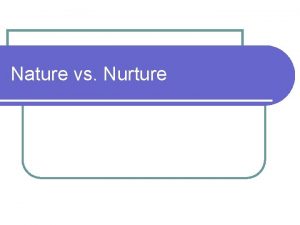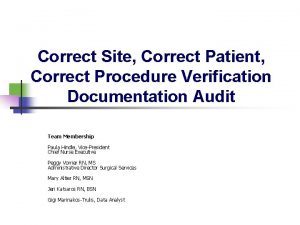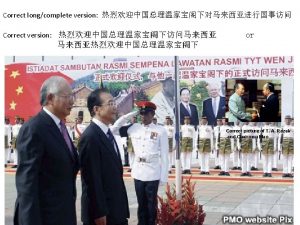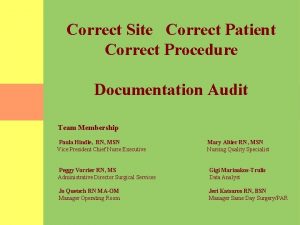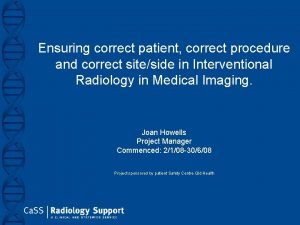Nature of Science Quiz Answers Correct answers are








- Slides: 8

Nature of Science Quiz & Answers Correct answers are in red and explanations for each option are at the bottom of the page

1. A scientist performs an experiment and asks other scientists around the world to replicate it. Why would other scientists most likely try to perform the same experiment? A. B. C. D. to find out if weather of various regions of the world would affect the results to see if the experiment would be less expensive in another part of the world to confirm the results of the experiment conducted by the scientist to verify that the hypothesis of the experiment is a scientific law A. Not the purpose of replication specifically. B. Not relevant to the study. C. The only one that makes sense. Replication is meant to verify one scientist’s study by comparing it to the results of the same study conducted by another scientist. D. A hypothesis and a scientific law are completely separate things.

2. Keesha did an experiment to study the rate of photosynthesis in the water plant Elodea. She placed a piece of Elodea in a beaker of water and set the beaker 10 centimeters (cm) from a light source. Keesha counted the bubbles released from the plant every minute for five minutes (min). She repeated the process two more times. First, she moved the light to 20 cm from the beaker, and then she moved the light to 30 cm from the beaker. Keesha’s setup and data are shown below. What is the outcome variable (dependent variable) in this experiment? A. the number of bubbles produced B. the type of plant placed in the beaker C. the amount of time the bubbles were counted D. the distance of the light source from the plant A. What is being observed and measured. Recorded on the data table. The only variable that Keesha has no control over. B. Part of the original experimental design. Not even recorded on the data table. C. Not relevant Not recorded on the data table D. Keesha has control over this variable She isn’t measuring this, it’s part of her original experimental design

3. Keesha did an experiment to study the rate of photosynthesis in the water plant Elodea. She placed a piece of Elodea in a beaker of water and set the beaker 10 centimeters (cm) from a light source. Keesha counted the bubbles released from the plant every minute for five minutes (min). She repeated the process two more times. First, she moved the light to 20 cm from the beaker, and then she moved the light to 30 cm from the beaker. Keesha’s setup and data are shown below. What type of data did Keesha collect? A. B. C. D. qualitative data number of bubbles quantitative data distance A. Uses words Category or description B. Data collected, not type of data collected C. Numeric (using numbers) measurement (i. e. number of bubble counted) D. Was not collected, is part of the original experimental design

4. Keesha did an experiment to study the rate of photosynthesis in the water plant Elodea. She placed a piece of Elodea in a beaker of water and set the beaker 10 centimeters (cm) from a light source. Keesha counted the bubbles released from the plant every minute for five minutes (min). She repeated the process two more times. First, she moved the light to 20 cm from the beaker, and then she moved the light to 30 cm from the beaker. Keesha’s setup and data are shown below. Based on her results, what might Keesha infer from her data? A. Plants don’t need light to produce bubbles B. The bubbles are proof that the water is boiling. C. The closer the light source, the more energy the plant has available to perform photosynthesis. D. The distance of the light from the beaker has no effect on the rate of photosynthesis. A. There was no treatment where she tested the number of bubble produced without light, so this hypothesis has no evidence. B. She didn’t heat the water during the experiment and did not collect data on water temperature, so no evidence to support this hypothesis. C. The plant produced more bubbles when it was closest to the light source (evidence of photosynthesis), and energy might be a possible explanation why. D. The amount of bubbles produced further away from the light source decreased, so the distance of the light might have an effect on the rate of photosynthesis.

5. The following statements were taken from the procedures of four different investigations. The statement from which investigation is an example of repetition? A. Investigation 1 B. Investigation 2 C. Investigation 3 D. Investigation 4 A. One study involving four treatments B. One study involving three different treatments C. One study involving five measurements D. Repeats the same exact study four times

5. The following statements were taken from the procedures of four different investigations. Which of the following describes a limitation of the drawing but NOT the clay model? A. It does not represent the main parts of a cell. B. It does not contain the correct number of nuclei. C. It cannot represent a living cell, since a true cell is three-dimensional. D. It cannot represent a living cell, since the cytoplasm should be in constant motion. A. Both the drawing and the clay model have the same parts of the cell represented. B. The number of nuclei is not relevant to the questions. Either way, you would not be able to determine that from the provided image. C. The clay model is a more accurate example of a cell because it can show much more detail and depth than a two-dimensional drawing. D. Neither the clay model nor the drawing can show the motions of any part of the cell.

Extra Credit: Explain the purpose of control groups and why they are important in scientific studies. Control groups provide baseline information to compare the experiment against. Without it, it’s impossible to know whether your experimental observations result from the variable you are testing or some other factor.


